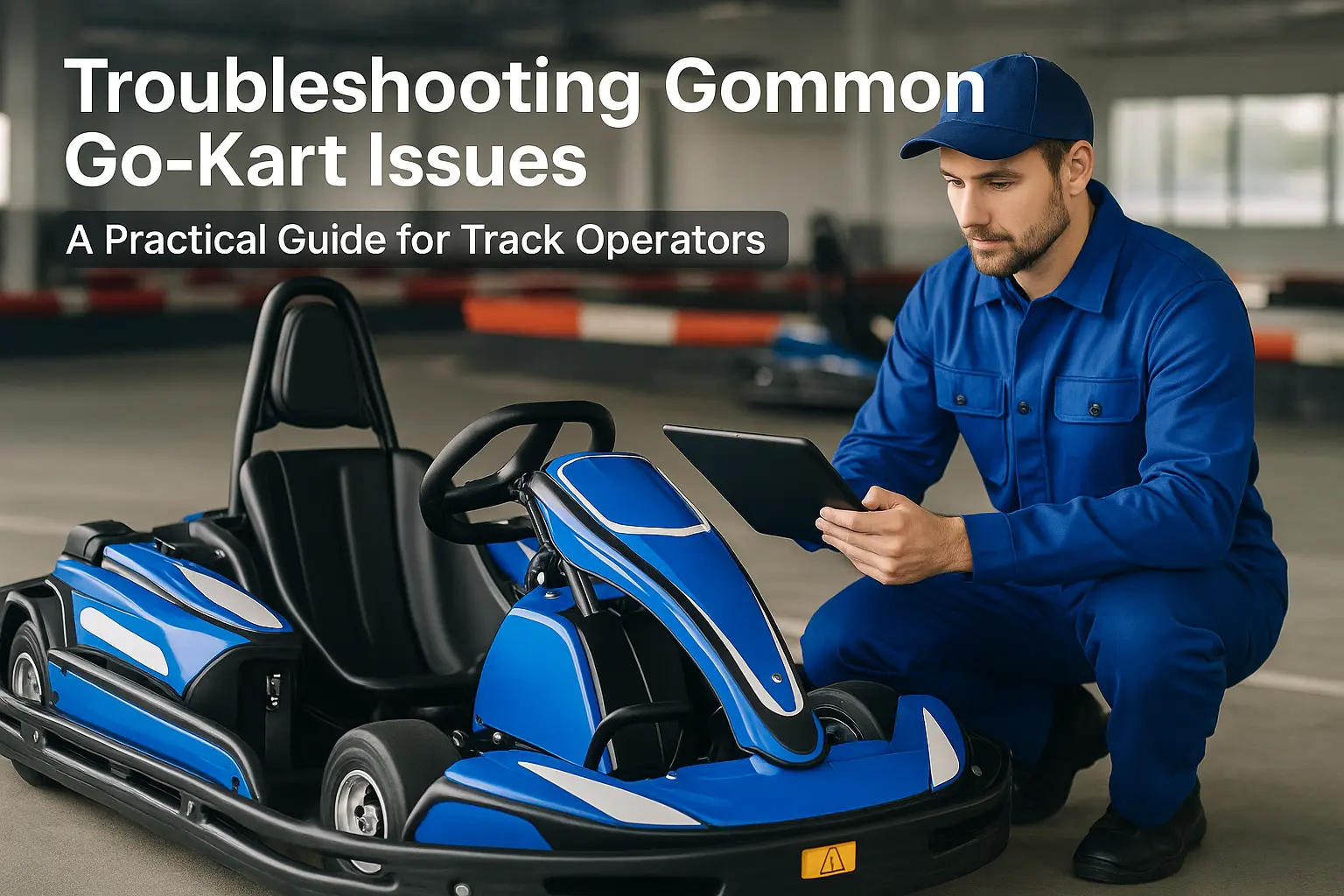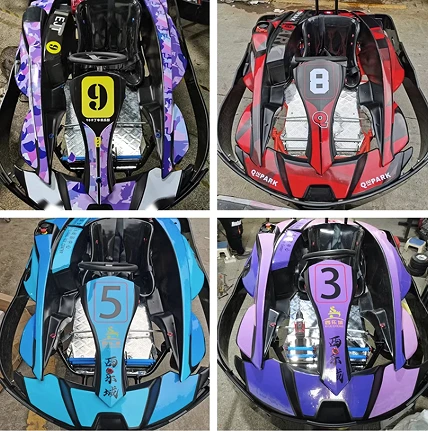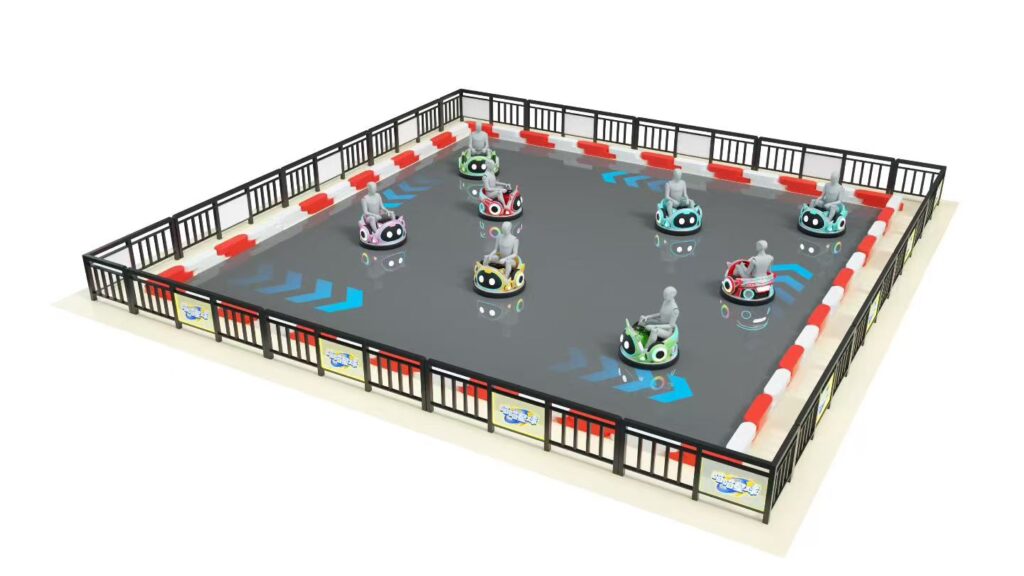Running a successful go-kart track means keeping your fleet in top condition. Every minute a kart sits idle is potential revenue lost and a disappointed customer. Whether you’re managing a small family entertainment center or a large racing facility, knowing how to quickly identify and fix common issues can make the difference between a smooth operation and a frustrating day of downtime.
This guide walks you through the most frequent problems track operators face with electric go-karts and provides practical solutions you can implement immediately. While some issues require professional attention, many can be resolved on-site with basic tools and knowledge.
Pre-Operation Inspection Checklist
Starting each day with a systematic inspection saves time and prevents problems before they escalate. A thorough pre-operation check takes about five minutes per kart but can prevent hours of downtime later.
Begin with a visual walk-around. Look for obvious damage to the body, bumpers, and frame. Check that all safety stickers are visible and intact. Inspect the seat and seatbelt for wear or damage. These visual cues often reveal issues before they become operational problems.
Test the accelerator and brake pedals for smooth movement without sticking. They should return to their resting position naturally. Push down on each corner of the kart to check the suspension feels consistent. Any unusual sounds or resistance warrants closer inspection.
Check tire pressure with a reliable gauge. Electric go-karts are sensitive to pressure variations, and even a few PSI difference can affect handling and battery efficiency. Most electric karts perform best between 12-15 PSI, but always refer to your manufacturer’s specifications. Look at the tread depth and check for uneven wear patterns that might indicate alignment issues.
Verify the battery charge indicator shows a full charge if the kart was on charge overnight. Check that charging port covers are secure and connections are clean. A quick test drive around the pit area confirms everything feels normal before customers arrive.

Power and Battery Problems
Battery-related issues are among the most common challenges for electric go-kart operators. Understanding how to diagnose these problems quickly keeps your fleet running smoothly.
When a kart won’t power on, start with the basics. Ensure the main power switch is in the on position and the emergency stop button isn’t engaged. Check the battery charge level on the display. If the display itself won’t turn on, the battery may be completely drained or there may be a connection issue.
Inspect the battery terminals for corrosion or loose connections. A white or green powdery substance around terminals indicates corrosion that can prevent proper electrical flow. Clean terminals with a wire brush and ensure connections are tight but not over-tightened.
Reduced speed or sluggish acceleration often points to battery degradation or charging issues. If a kart that normally reaches full speed feels noticeably slower, check when it was last fully charged. Some batteries develop a memory effect if consistently only partially charged. Running a complete discharge and full charge cycle can sometimes restore performance.
Battery draining faster than normal suggests either battery aging or increased resistance somewhere in the system. Compare runtime data against the kart’s normal performance. If a battery that typically lasts 20 minutes is dying after 10, it’s time for deeper investigation. Check for dragging brakes that create constant resistance. Feel the brake rotors after a short run—they should be slightly warm but not hot.
Charging port problems often stem from debris or moisture. Inspect the port for dirt, bent pins, or burn marks. Keep ports clean and dry. If a kart isn’t charging, try a different charging cable to rule out cable failure before assuming the port is damaged.
Modern electric go-karts from quality manufacturers like Minye Fun incorporate sophisticated battery management systems that protect against overcharging and deep discharge. However, these systems can sometimes throw error codes. Consult your diagnostic guide for specific code meanings, but common ones relate to temperature limits or cell imbalance.

Steering and Handling Issues
Steering problems affect both safety and the customer experience. A kart that doesn’t handle well creates frustrated drivers and potential safety hazards.
Loose or unresponsive steering usually indicates worn tie rod ends or loose steering column bolts. Lift the front of the kart and grab the wheel at 3 and 9 o’clock positions. Try to wiggle it. There should be minimal play. Excessive movement means components need tightening or replacement. Check that the steering wheel nut is properly torqued and hasn’t worked loose.
If a kart consistently pulls to one side, start by checking tire pressure. A difference of just 2-3 PSI between left and right can cause noticeable pulling. If pressures are equal, inspect for dragging brakes on one side. Spin each wheel freely—they should rotate smoothly without resistance.
Alignment issues develop over time through normal use and occasional impacts. While precise alignment requires specialized equipment, you can perform a basic check. With the kart on level ground and the steering wheel centered, the front wheels should point straight ahead. Sight down each side of the kart. If one wheel points noticeably inward or outward, alignment adjustment is needed.
Vibrations during operation have several potential causes. Unbalanced or damaged wheels create vibration that increases with speed. Inspect wheels for cracks, missing chunks, or deformation. Spin each wheel and watch for wobble. Loose wheel nuts are another common culprit—check torque regularly.
Bent axles or spindles from impacts cause persistent vibration and handling problems. These require replacement rather than repair. If vibration is accompanied by unusual noise, the issue could be worn bearings. Lift the kart and spin wheels by hand, listening for grinding or roughness.

Brake System Troubles
Reliable brakes are non-negotiable for safe operation. Electric go-karts use regenerative braking combined with mechanical systems, and both aspects need attention.
Weak or spongy brake response in mechanical systems often indicates air in hydraulic lines or low brake fluid. Check the fluid reservoir level first. If low, inspect for leaks around calipers and brake lines. Air can enter the system through loose connections or damaged seals. Bleeding the brakes removes air and restores firm pedal feel.
For electric karts with primarily regenerative braking, weak response may indicate motor controller issues rather than mechanical problems. The system should provide strong initial braking force as the motor acts as a generator. If this initial bite is missing, the controller may need recalibration or replacement.
Brake dragging creates excess heat, reduces speed, and drains batteries faster. After a short run, carefully feel each brake rotor. All should be similarly warm. A significantly hotter rotor indicates that brake is dragging. Common causes include sticking calipers, improperly adjusted brake cables, or warped rotors.
Uneven braking, where one wheel locks before others, creates handling problems and uneven tire wear. Check brake pad thickness on all wheels. Pads wear at different rates depending on their position and usage patterns. Replace pads in sets to maintain even braking.
The parking or emergency brake system needs regular testing. It should hold the kart firmly on a slope without creeping. A weak emergency brake may just need cable adjustment, but worn components require replacement. This system is your backup if the main braking fails, so it must be reliable.

Motor and Drive System
Electric motors are generally reliable, but recognizing early warning signs prevents costly failures.
Unusual noises during acceleration deserve immediate attention. A high-pitched whine might indicate bearing wear in the motor. Clicking or clunking sounds often point to drive components like belt or chain issues. Grinding noises suggest metal-on-metal contact somewhere.
Listen to your karts regularly so you recognize what normal sounds like. Any change in the typical motor hum or drive system noise warrants investigation. Run the kart on a lift to isolate sounds without road noise interference.
Intermittent power loss is challenging to diagnose because it’s not constant. The kart runs normally, then suddenly loses power, then recovers. This pattern often indicates loose electrical connections that make and break contact with vibration. Systematically inspect and secure all wiring harnesses, paying special attention to connection points that experience movement.
Temperature-related power loss occurs when thermal protection systems kick in. Modern electric motors include sensors that reduce power or shut down if temperatures exceed safe limits. If a kart loses power after extended use but recovers after cooling, check that cooling fans are operating and air passages are clear. Debris blocking airflow causes overheating.
Belt-driven systems require proper tension. A loose belt slips, especially under acceleration, causing power loss and belt wear. Too tight creates excessive bearing load and premature failure. The belt should deflect about half an inch when pressed firmly at its midpoint between pulleys. Check belt condition regularly for cracks, fraying, or glazing.
Chain-driven systems need regular lubrication and tension adjustment. A dry chain wears rapidly and creates noise. Chains stretch over time and need periodic adjustment to maintain proper tension. Inspect sprockets for worn or hooked teeth that indicate it’s time for replacement.
Quality electric go-karts like those from Minye Fun feature sealed drive systems that minimize maintenance requirements. However, periodic inspection remains important. Check that protective covers are secure and that no debris has entered the system.

Safety System Malfunctions
Safety systems protect both operators and customers, so they must function perfectly.
Seatbelt sensors prevent kart operation if the belt isn’t fastened. When these malfunction, karts either won’t start despite belted drivers or start without belts fastened—both are problems. Clean the sensor connection points first. Dirt or corrosion can prevent proper contact. If cleaning doesn’t help, test the sensor with a multimeter following manufacturer specifications.
Speed limiters allow you to adjust maximum kart speed based on driver age or skill level. If a kart exceeds its programmed limit or won’t reach expected speed, the limiter may need recalibration. Most systems use either mechanical governor systems or electronic controllers. Electronic systems typically require computer interface for adjustment, while mechanical systems use spring tension adjustment.
Emergency stop buttons must be easily accessible and immediately effective. Test each button weekly by pressing it during operation. The kart should stop instantly and require deliberate reset to restart. Buttons that stick, don’t engage, or don’t cut power need immediate replacement.
Bumper damage affects more than appearance. Bumpers absorb impacts and protect both the kart and drivers. Cracks or loose mounting points compromise protection. Inspect mounting bolts regularly and ensure bumpers aren’t pushed inward toward moving components.
Body panels and fairings protect internal components and prevent clothing or fingers from reaching moving parts. Missing panels or those with sharp edges create safety hazards. Replace damaged body parts promptly rather than attempting repairs that might not hold up under impact.

Diagnostic Tools and Resources
Having the right tools makes troubleshooting faster and more accurate.
Every track should maintain a basic toolkit including various wrenches, sockets, screwdrivers, pliers, and Allen keys. Invest in good quality tools—cheap ones round off bolt heads and create more problems. A torque wrench ensures critical fasteners are properly tightened without over-tightening.
Electrical diagnostics require a digital multimeter for testing voltage, resistance, and continuity. This simple device helps identify battery issues, broken wiring, and sensor problems. Learn basic testing procedures like checking battery voltage under load and testing sensor output.
Tire pressure gauge, tire tread depth gauge, and wheel alignment tools specific to your kart model help maintain consistent handling across your fleet. A pyrometer for measuring tire temperatures helps diagnose suspension and alignment issues.
Many modern electric go-karts include onboard diagnostic systems accessible through display screens or computer interfaces. Learn to read error codes and understand what they indicate. Keep the diagnostic manual readily available. Some manufacturers provide smartphone apps for fleet monitoring that alert you to issues before they cause failures.
Know when to call in professionals. Complex electrical repairs, major collision damage, and motor replacements typically exceed the capabilities of standard track maintenance. Establish relationships with qualified technicians who understand electric vehicle systems.
Create a digital maintenance log for each kart in your fleet. Track operating hours, repairs performed, parts replaced, and any recurring issues. This history helps identify patterns and predict maintenance needs. Simple spreadsheet software works fine, or use specialized fleet management applications.

Preventive Maintenance Schedule
Systematic preventive maintenance dramatically reduces unexpected breakdowns and extends kart life.
Daily tasks take just minutes per kart but catch problems early. Start each day with the pre-operation inspection outlined earlier. Before customers arrive, test drive each kart briefly. This confirms everything works and gives you feel for any developing issues. Check battery charge levels and connect any karts that need charging.
Weekly maintenance goes deeper. Clean karts thoroughly, removing dirt and debris that can hide damage or cause wear. Deep clean charging ports and electrical connections. Check all fluid levels including hydraulic brake fluid and motor coolant if applicable. Inspect wear items like brake pads and tires, measuring actual values rather than just looking.
Torque-check critical fasteners including wheel nuts, steering components, and motor mounts. Vibration gradually loosens bolts, and a systematic weekly check prevents problems. Lubricate moving parts according to manufacturer specifications. Over-lubrication attracts dirt, so use recommended amounts.
Monthly maintenance includes more time-intensive tasks. Perform complete mechanical inspection of steering and suspension systems. Check for worn bushings, bent components, or developing cracks. Test all safety systems thoroughly including emergency stops and seatbelt sensors.
Review battery performance data. Batteries that show significant degradation compared to fleet average may need replacement soon. Deep clean and detail karts to maintain their appearance and allow close inspection of all components.
Seasonal deep maintenance prepares karts for heavy use periods or addresses issues from off-season storage. Change any fluids that have maintenance intervals measured in months rather than hours. Inspect electrical systems thoroughly, looking for corroded connections or damaged wiring. Test drive karts under various conditions to ensure consistent performance across the fleet.
Replace wear items on a schedule rather than waiting for failure. Brake pads, tires, and drive belts have predictable lifespans. Track operating hours and replace components at recommended intervals. This prevents mid-session failures that disappoint customers.
Staff training is ongoing maintenance for your team. Ensure all operators know how to perform daily inspections and recognize problems. Teach basic troubleshooting so staff can handle simple issues without escalation. Cross-train multiple people on each task so you’re not dependent on one person’s expertise.
Conclusion
Effective troubleshooting combines systematic inspection, quick diagnosis, and appropriate response. The problems outlined in this guide represent the majority of issues track operators encounter daily. By developing expertise in these areas, you minimize downtime and maintain customer satisfaction.
Build a troubleshooting protocol for your facility. When issues arise, staff should know exactly what steps to take: safe shutdown, initial assessment, decision to repair or sideline, and communication process. Written procedures eliminate confusion during busy periods.
Minimize track downtime through preparation rather than reaction. Maintain adequate spare parts inventory for common failures like fuses, cables, and brake pads. Know which issues can wait until end of day and which require immediate attention. A kart with a cosmetic body crack can keep running, but one with brake problems must be sidelined immediately.
Invest in quality equipment from the start. Premium electric go-karts like those from Minye Fun feature robust construction, quality components, and excellent support resources. While initial costs are higher, reliable equipment reduces long-term maintenance burden and operating costs. The difference between cheap karts that constantly break down and quality karts that run reliably becomes obvious quickly.
Document everything. Photos of unusual wear patterns, notes on intermittent problems, and records of solutions that worked all build institutional knowledge. When similar issues arise later, you have reference materials instead of starting from scratch.
Stay connected with other track operators through industry associations and online forums. Sharing experiences helps everyone improve. Many operators have solved the exact problem you’re facing and are willing to share solutions.
Consider manufacturer training programs if available. Hands-on training from engineers who designed the karts provides insights impossible to gain otherwise. This investment pays back through faster troubleshooting and better maintenance decisions.
Remember that preventing problems is always easier and cheaper than fixing them. Time spent on systematic preventive maintenance returns multiples in reduced breakdown costs and improved customer experience. A well-maintained fleet runs more hours, generates more revenue, and requires fewer emergency repairs.
Keep learning and adapting your procedures based on experience. Every season brings new insights into what works best for your specific operation. The goal isn’t perfection but continuous improvement toward higher reliability and lower operating costs.
With the knowledge and procedures outlined in this guide, you’re equipped to handle the vast majority of common go-kart issues. Your customers will enjoy consistent, safe, thrilling experiences. Your business benefits from maximized uptime and controlled maintenance costs. That’s the foundation of successful track operation.




